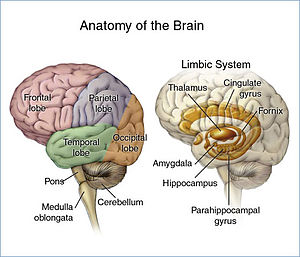Startle response
In animals, including humans, the startle response is a largely unconscious defensive response to sudden or threatening stimuli, such as sudden noise or sharp movement, and is associated with negative
Startle reflex
Neurophysiology

A startle reflex can occur in the body through a combination of actions. A reflex from hearing a sudden loud noise will happen in the primary acoustic startle reflex pathway consisting of three main central
First, there is a synapse from the
During neuromotor examinations of newborns, it is noted that, for a number of techniques, the patterns of the startle reaction and the Moro reflex may significantly overlap, the notable distinction being the absence of arm abduction (spreading) during startle responses.[7]
Reflexes
There are many various reflexes that can occur simultaneously during a startle response. The fastest reflex recorded in humans happens within the masseter muscle or jaw muscle. The reflex was measured by electromyography which records the electrical activity during movement of the muscles. This also showed the response latency, or the delay between the stimulus and the response recorded, was found to be about 14 milliseconds. The blink of the eye which is the reflex of the orbicularis oculi muscle was found to have a latency of about 20 to 40 milliseconds. Out of larger body parts, the head is quickest in a movement latency in a range from 60 to 120 milliseconds. The neck then moves almost simultaneously with a latency of 75 to 121 milliseconds. Next, the shoulder jerks at 100 to 121 milliseconds along with the arms at 125 to 195 milliseconds. Lastly the legs respond with a latency of 145 to 395 milliseconds. This type of cascading response correlates to how the synapses travel from the brain and down the spinal cord to activate each motor neuron.[8]
Acoustic startle reflex
The acoustic startle reflex is thought to be caused by an auditory stimulus greater than 80 decibels.
The amygdala is known to have a role in the "fight-or-flight response", and the hippocampus functions to form memories of the stimulus and the emotions associated with it.[13] The role of the BNST in the acoustic startle reflex may be attributed to specific areas within the nucleus responsible for stress and anxiety responses.[12] Activation of the BNST by certain hormones is thought to promote a startle response[12] The auditory pathway for this response was largely elucidated in rats in the 1980s.[14] The basic pathway follows the auditory pathway from the ear up to the nucleus of the lateral lemniscus (LLN) from where it activates a motor centre in the reticular formation. This centre sends descending projections to lower motor neurones of the limbs[clarification needed].
In slightly more detail this corresponds to ear (
Application in occupational settings
A study undertaken in 2005 by researchers at the Department of Aviation and Logistics,
See also
- Escape response
- Jumping Frenchmen of Maine
- Jump scare
- Prepulse inhibition – attenuation of the startle response after a weaker preceding prepulse stimulus
- Surprise (emotion)
References
- ^ a b Rammirez-Moreno, David. "A computational model for the modulation of the prepulse inhibition of the acoustic startle reflex". Biological Cybernetics, 2012, p. 169
- PMID 2200076.
- PMID 1744643.
- PMID 10200438.
- PMID 10899184.
- ^ Davis, M. (2007). "Neural systems involved in fear and anxiety based on the fear-potentiated startle test." Neurobiology of Learning and Memory (pp. 381–425). Elsevier Incorporated.
- ISBN 978-0397513864.
- ^ Davis, M. (1984). "The mammalian startle response". In R. Eaton (Ed.), Neural stop of Startle Behavior (pp. 287–351). Plenum Publishing Corporation.
- The European Journal of Neuroscience, 2003, p. 1325
- Behavioral Neuroscience, 1992, p. 274
- ^ a b Medford, Nick. "Conjoint Activity of Anterior Insular and Anterior Cingulate Cortex:Awareness and Response". Brain Structure and Function, 2010, p. 535
- ^ a b c Lee, Younglim. "Role of the Hippocampus, the Bed Nucleus of the Stria Terminalis, and the Amygdala in the Excitatory Effect of Corticotropin-Releasing Hormone on the Acoustic Startle Reflex". The Journal of Neuroscience, 1997, p. 6434
- Journal of the American Academy of Child & Adolescent Psychiatry, 2010, p. 552
- PMID 7086484.
- S2CID 19678962.
- ^
 Martin, Wayne; Murray, Patrick; Bates, Paul (2012). The Effects of Startle on Pilots During Critical Events: A Case Study Analysis (PDF). 30th EAAP Conference : Aviation Psychology & Applied Human Factors – working towards zero accidents. Discussion, p. 389. Archived (PDF) from the original on 2019-09-16. Retrieved 2019-09-12.
Martin, Wayne; Murray, Patrick; Bates, Paul (2012). The Effects of Startle on Pilots During Critical Events: A Case Study Analysis (PDF). 30th EAAP Conference : Aviation Psychology & Applied Human Factors – working towards zero accidents. Discussion, p. 389. Archived (PDF) from the original on 2019-09-16. Retrieved 2019-09-12.
- ^ Field, JN; Boland, EJ; van Rooij, JM; Mohrmann, JFW; Smeltink, JW. Startle Effect Management (Report Number NLR-CR-2018-242) (PDF) (Report). European Aviation Safety Agency. 2.4.3 Fear-potentiated Startle or Surprise, p. 18. Retrieved 2019-09-12. cited Martin, W; Murray, P (2013). Training Interventions for Managing Startle During Unexpected Critical Events. 66th International Air Safety Summit. Flight Safety Foundation.
- S2CID 147250211.
- Carney Landis; William Alvin Hunt; Hans Strauss (1939). The startle pattern. Farrar & Rinehart., review [1]
- Robert C. Eaton (1984). Neural Mechanisms of Startle Behavior. Springer. ISBN 978-0306415562.
- Jones, FP; Hanson, JA; Gray, FE (1964). "Startle as a Paradigm for Malposture". Perceptual and Motor Skills. 19: 21–22. S2CID 10095410.
- Jones, FP (1965). "Method for Changing Stereotyped Response Patterns by the Inhibition of Certain Postural Sets". Psychological Review. 72 (3): 196–214. PMID 14324557.
